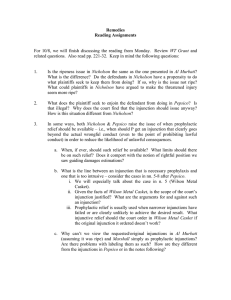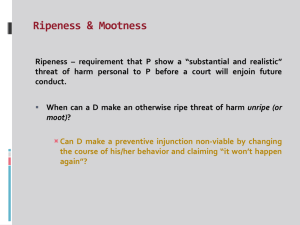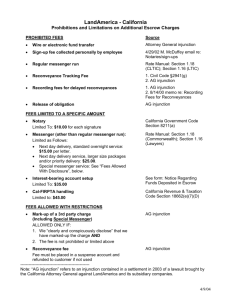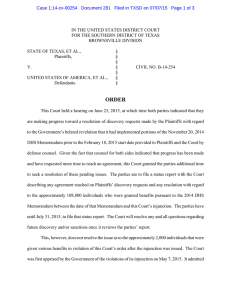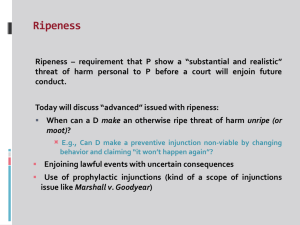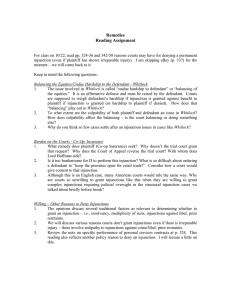WHAT IS AN INJUNCTION?
advertisement
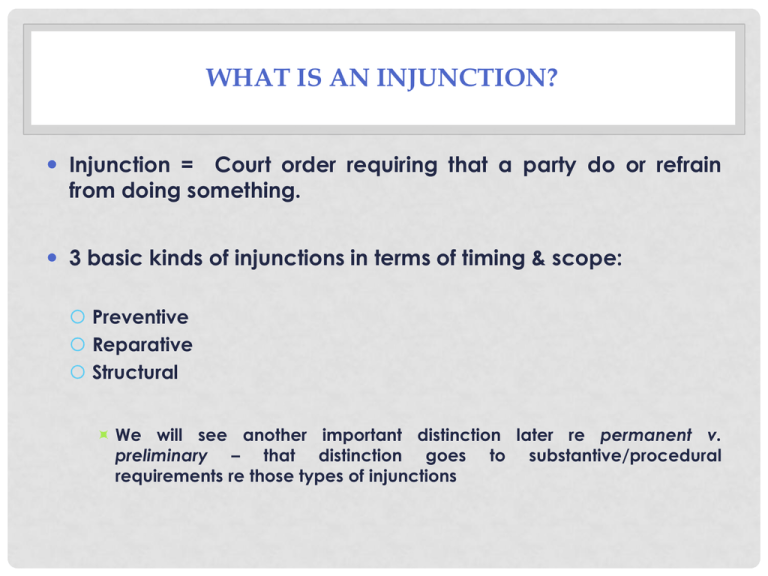
WHAT IS AN INJUNCTION? Injunction = Court order requiring that a party do or refrain from doing something. 3 basic kinds of injunctions in terms of timing & scope: Preventive Reparative Structural We will see another important distinction later re permanent v. preliminary – that distinction goes to substantive/procedural requirements re those types of injunctions PREVENTIVE INJUNCTIONS • Preventive Injunction = An injunction seeking to prevent future violations of the law. • Critical Question: What are the circumstances in which future conduct can be enjoined? AL MURBATI v. BUSH • What did the plaintiffs fear the government was going to do? • Why wouldn’t the court grant an order barring the gov’t from engaging in those actions? • What evidence did P’s have that the government was likely to engage in those actions? PREVENTIVE INJUNCTIONS & RIPENESS P must show a “substantial and realistic” threat of harm personal to P before a court will enjoin future conduct. Another way of saying this: P must show D’s “propensity” to commit the harmful act. The “ripeness” showing is heavily evidentiary in nature. P must offer proof - must be something more than raw fear or simple theories Ripeness requirement applies to all injunctions seeking to regulate future conduct – whether permanent or preliminary. PREVENTIVE INJUNCTIONS, RIPENESS, & EVIDENTIARY SUPPORT • Would the harm in Al Murbati more likely have been ripe if: • Ps had evidence that in some countries (including home countries) to which detainees were shipped the “diplomatic assurances” that no torture would occur were illusory and ineffective? • What if P presented strong evidence that U.S. officials lied about aspects of its treatment of detainees BUT there was no evidence that it lied about this particular treatment of detainees? Would a court be more likely to think the threatened harm was ripe? • What evidence would be necessary to show a ripe threat of harm that P’s would be transferred to a country where they would be tortured? PREVENTIVE INJUNCTIONS, RIPENESS & TAILORING • Even if Al-Murbati P’s could prove they were likely to be shipped to a country that would torture them (i.e., the feared harm was ripe), would a court grant P’s requested injunction? • Requested injunction: Bars the government from transferring any P out of Guantanamo without 30 days notice to the court or P’s counsel. • What do Marshall (and what we’ve learned about the ripeness rule) suggest about whether the scope of the requested injunction in Al Murbati was appropriate? THE SCOPE OF PREVENTIVE INJUNCTIONS WITH MULTIPLE ACTORS – POSSIBLE OPTIONS IN MARSHALL V. GOODYEAR Marshall v. Goodyear – Nationwide injunction for a single act of age discrimination at Auburndale branch inappropriate. Possible options for injunction – which is most appropriate? Order barring “Auburndale branch of Goodyear from violating employment discrimination laws.” Order barring the “Auburndale branch of Goodyear from engaging in acts that discriminate based on age in violation of the ADEA, including hiring, promotions and firing of employees.” Order barring the “Manager of the Auburndale branch of Goodyear from engaging in acts that discriminate based on age in violation of the ADEA, including hiring, promotions and firing of employees.” Order barring the “Manager of the Auburndale branch of Goodyear from discharging employees in violation of ADEA.” When is company-wide injunction justified? MARSHALL HYPO (P. 214 N.3) – WHEN IS A COMPANY-WIDE INJUNCTION APPROPRIATE • Reed in Marshall was discharged due to a company policy that all assistant managers should be under the age of 30 – what is the appropriate injunction? • Nationwide injunction appropriate? • To enjoin what? • • • • that particular policy? All age discrimination in hiring and firing? All violations of ADEA? All age discrimination involving managerial positions? • Does Reed represent all potential plaintiffs or should there be a class action? WHO DOES THE INJUNCTION PROTECT? • When the court issues an injunction does it protect plaintiff only? Persons similarly situated to plaintiff? • Note on page 217 has a nice discussion on these issues. Recent courts are tending toward saying that injunction protects only plaintiffs unless there is a class action. • In Miller v. Davis, the original injunction against Kim Davis stated: “IT IS FURTHER ORDERED that Defendant Kim Davis, in her official capacity as Rowan County Clerk, is hereby preliminarily enjoined from applying her “no marriage licenses” policy to future marriage license requests submitted by Plaintiffs.” • Who benefits – only named plaintiffs or all potential applicants? • See clarified order. MOOTNESS AS AN ASPECT OF RIPENESS What happens when a ripe threat becomes “unripe” because of D’s actions? Or put another way – when can a D make an otherwise ripe threat of harm unripe? Can D make a preventive injunction non-viable by changing the course of their behavior and claiming “it won’t happen again”? JURISDICTIONAL VS. EQUITABLE MOOTNESS – AS DISTINGUISHED IN WT GRANT • Jurisdictional: Mootness/Lack of ripeness is an Article III issue. Court must dismiss for lack of jurisdiction as required by U.S. Constitution. • Unripe/Moot: No reasonable expectation that the wrong will be repeated • Equitable: Mootness/Lack of ripeness is simply an equitable issue. Court can dismiss as a matter of judicial discretion • Unripe/moot: No cognizable danger or no more than a mere possibility that the harm will re-occur MOOTNESS (AKA UNRIPENESS) IN W.T. GRANT – 3 FACTORS RE WHETHER INJUNCTION SHOULD ISSUE 1. Bona Fides of D’s Expressed Intent to Comply 2. Effectiveness of D’s Discontinuance of Bad Acts • Effort devoted to ending violation • Difficulty in starting up again 3. Character of D’s Past Violations • Intentional v. Negligent • Pattern v. Isolated Incident • Temptation Inherent in the Job
